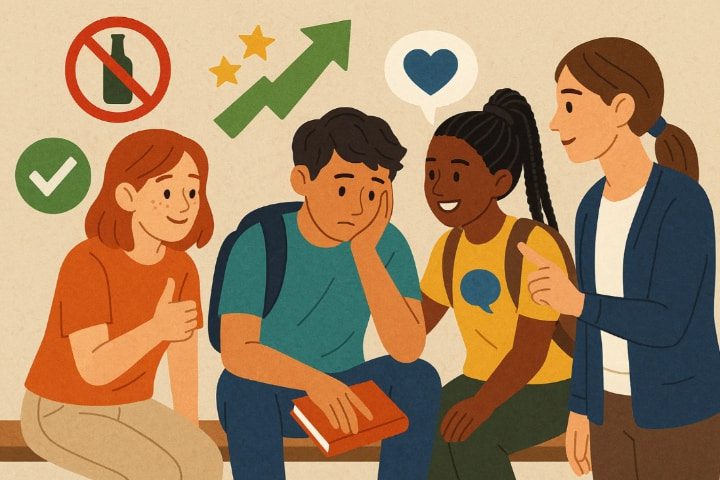Peer pressure simply refers to actual influence by peers, schoolmates, classmates and virtual communities. The impact of that power is in the decisions made concerning school, health, media and behavior. It occasionally tempts towards shortcuts or dangerous trends. Other times, it motivates healthier habits, better study skills and more pleasant behavior. This article unpacks both sides with a focus on positive peer pressure. Further, it provides steps that are practical and are friendly to the parents with a brief tour of the digital tools. These are useful in helping families know the online worlds of kids without guesswork.
What is peer pressure?
Peer pressure is influenced by a peer group that causes an individual to alter their attitude, choice or behavior. Age, interests, classes, teams or online spaces can be shared by peers. That influence may be either direct as a friend pressures one to make a decision or indirect as a trend establishes a norm. According to researchers, such a widespread effect is referred to as social, or peer influence in all ages.



There are both supportive and harmful versions of influence. Research and guidance provided by schools observe that peer groups may prepare towards both healthy and unhealthy behavior. For example, consider one student who does not skip classes. Their circle of friends starts to skip school regularly and discuss it like it were something exciting and not harmful. In the long run, the student simply begins to feel excluded and concerned about being looked upon as different. The student will choose not to attend classes as well, even without someone explicitly telling them to do so, just to be a part of the group.
Use parental controls to protect your teens from bad online impact.
Explore the definition of positive peer pressure
Positive peer pressure is the group effect that lifts behavior, performance, and well-being. It sets high yet humane norms and makes constructive choices feel expected, not unusual.
- Encouragement toward constructive behaviors
This form of peer pressure encourages actions that simply align with health, learning, ethics, and community standards. Friends applaud punctuality, extol labor, and open-minded gestures
- Group influence
Collective expectation is basically the key. Favorable peers make good behavior become the default. An adolescent joining such a group usually goes up to the common standard. The Usable Knowledge study of Harvard sheds light on the fact that peer influence can be productive in a situation when adolescents join groups of peers who have healthy objectives and values.
- Supportive peers
“People care about what others think across all different age groups and that influences how much they value different ideas and behaviors,” notes Dr. Emily Falk, a social influence researcher. This shows why constructive norms are so important: when a group prioritizes effort, prosocial conduct and safety, members tend to internalize those values. Because people are influenced by the standards set around them, peer pressure can work very positively and make good behavior contagious rather than destructive. Clinical and school-based experts further emphasize that peers can model and reinforce healthy skills, particularly during adolescence when the need for belonging strongly shapes decisions.
Positive peer pressure vs. negative peer pressure
Peer pressure simply never looks the same in every situation. Sometimes it really pushes toward growth, while other times it drifts into harmful choices. A clear comparison between positive and negative peer pressure makes it easier to spot which influence is at play.
- Positive peer pressure
This pressure pushes toward healthier routines with stronger study habits and inclusive behavior. It celebrates progress, values honesty and offers real support, helping individuals build resilience plus responsibility and lasting confidence in daily life and learning.
- Negative peer pressure
Negative peer pressure creates pressure to take risks, break rules, or hurt others. It promotes shortcuts, mocks personal boundaries and also punishes differences. The outcome often includes regret, guilt and behavior that undermines long-term goals and wellbeing.
- Positive signals
Encouragement basically shows up through praise, invitations to join healthy activities, shared study plans or reminders about safety. These signals simply motivate constructive choices, making good habits feel normal and reinforcing cooperation that benefits both individuals and peer groups together.
- Negative signals
Warning signs include dares that push danger, ridicule for saying no, rumor-spreading to isolate or glamorizing harmful trends. These signals pressure individuals into unsafe actions, foster exclusion and create environments where destructive behavior becomes normalized.
- Outcome
Positive influence strengthens skills, self-control and belonging. It leaves individuals with greater confidence and healthier habits. Negative influence, in contrast, drives stress, guilt and harm, often pushing people away from their values or exposing them to serious risks.
The real-life examples of constructive peer pressure
- Classmates establish a homework club and hold one another to a steady, uninterrupted schedule.
- Before going to sleep, teammates settle on a device-off period during practice time to ensure sleep and concentration.
- Buddies spread the word of bullying and support victims in the open, establishing a zero-tolerance standard.
- Group chats in the digital world are used to fact-check health information with reliable sources and to discontinue rumor-mongering.
- Student councils advance attendance challenges which give credit to consistency of effort instead of uncooked test scores.
- School cultures with a large number of graduates going to college raise the number of applications of younger cohorts, as there is an uplift in plans with shared expectations.
- Friends who appreciate studying provide benchmarks that motivate one to study relentlessly. The use of group study, mutual deadlines and achievable objectives makes people stay motivated, eliminate procrastination, and work better. It shows positive peer pressure because the group sets shared standards that gently push everyone to keep up and stay disciplined.
- Friends who have discipline regarding schedules, time of device use and the importance of rest give good examples. Through this form of routine, people gain self-control, are able to better manage distractions and build habits that allow them to have balanced lifestyles and become productive academically. This is an example of positive peer pressure because seeing disciplined peers motivates others to follow their routines, improving collective productivity.
- Sporting, physical activity, diet and hydration groups are the ones that facilitate normalization of wellness. Peer circles make healthier lifestyles appealing, feasible and viable in their daily practice. This discourages substance use and rejoicing over the minor health achievements. Positive peer pressure works here by actually normalizing healthy habits and making individuals feel encouraged to follow the group’s standard of wellness.
- Positive peer influence simply makes reaching out for guidance or professional counseling socially acceptable. Acts of kindness and also shared support reduce stigma and usually encourage openness. Thus, it ensures people to feel comfortable asking for help without shame or judgment. In this case, positive peer pressure removes barriers and stigma. It is very easy now for individuals to simply seek help because their peers support and normalize it.
- Loss of individuality as all people may follow the group too much and stop thinking for themselves.
- Stress to perform as the constant pressure to always “do good” can create anxiety and burnout.
- Those who cannot keep up with the group’s positive standards may simply feel left out.
- Unrealistic expectations such as good behavior can turn harmful if the standards are too high or rigid.
- Positive influence can slip into comparison, making peers compete instead of support.
- Map current circles. Lists close friends, teams, and online groups; note which ones uplift or drain.
- Spotlight models. Invite stories that celebrate effort, kindness and honest problem-solving.
- Set micro-norms at home. This includes quiet hours, device-free dinners, and Sunday planning sessions.
- Follow constructive creators. Simply mute drama, gossip and pressure-heavy accounts.
- Practice response scripts. Just role-play simple “no thanks, let’s do it instead” lines until they feel natural.
- Build pro-social squads. Encourage study buddies, service clubs or team sports with supportive peers.
- Screen Time limits, App Blocker, Screen Mirroring, Remote Camera, and One-Way Audio help you understand a child’s device use and surroundings in real time.
- This tool can also help you monitor screen habits, spot risky patterns and start timely conversations while keeping autonomy in view.
- Always pair monitoring with clear rules, consent and open dialogue for the best results.
The power of positive peer pressure: benefits and advantages
Supportive groups make constructive behavior feel normal and desirable, especially for children and teens. Below are discussed key benefits:
Potential risks: can motivational peer influence become harmful?
Even positive group norms can overreach. High standards can morph into anxiety if perfection replaces growth. The following are risks and balance points, everyone must know:
For parents: How to encourage supportive peer pressure?
Families can steer peer influence toward growth by shaping environments, conversations, and digital habits. Below are discussed some useful and important tips for parents to handle and manage this in their kids:
Use a parental control app
Parental control tools help you monitor your child’s online activity. This also guides kids on what to do if friends pressure them to join unsafe groups or challenges. They limit access to harmful content which lowers the chance of your child copying risky behaviors from peers. These apps also give you insights into your child’s social interactions, making it easier to start open conversations about handling peer pressure in a healthy way. Parental control tools can provide visibility without guesswork.
One of the top-rated and most trusted parental control apps is FlashGet Kids. This offers many state-of-the-art features in this regard:



Wrap up
Peer pressure is simply two-sided. Positive peer pressure depends on a good circle as it boosts behavior, health and purpose; negative circles drive short-cuts, shame or danger. The positive aspect can be enhanced by families and schools that place humane norms, glorify efforts and create inclusive communities.
Under consistent guidance, peer pressure serves as a growth support as opposed to a stressor, thus enabling the youths to train skills that are here to stay.
FAQs
There are five such examples and joining studying groups that will help to learn regularly. This includes doing community service with friends, telling the truth in tough situations, having positive habits such as sports, spending hours without gadgets, and enjoying sleep, concentration and healthier relationships in general.
Definitely, peer pressure may have a good side when friends and classmates make positive decisions. Positive peer influence is a useful motivator to self-development and strength as supportive groups contribute to academic concentration, discourage risk-taking, normalize benevolence, and strengthen good habits.
One good illustration is when fellow students are forming a homework club, which can meet with each other on a regular basis. By cheering on each other, keeping each other accountable and giving useful assistance, the group forms a healthy environment. That further enhances accountability, minimizes stress and enhances learning outcomes largely.

